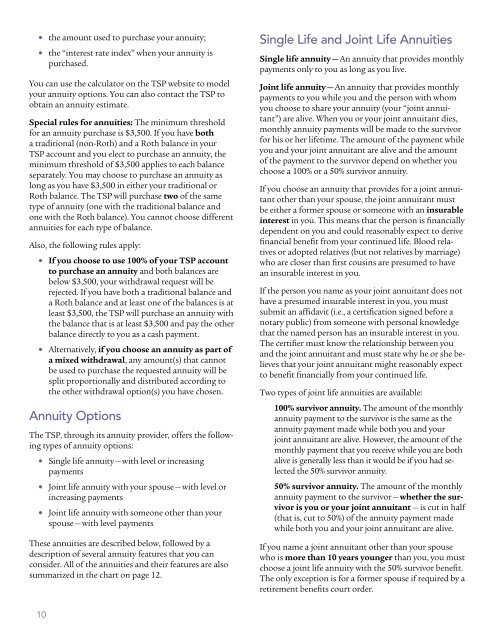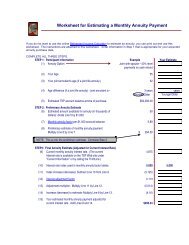tspbk33
Create successful ePaper yourself
Turn your PDF publications into a flip-book with our unique Google optimized e-Paper software.
• the amount used to purchase your annuity;<br />
•<br />
the “interest rate index” when your annuity is<br />
purchased.<br />
You can use the calculator on the TSP website to model<br />
your annuity options. You can also contact the TSP to<br />
obtain an annuity estimate.<br />
Special rules for annuities: The minimum threshold<br />
for an annuity purchase is $3,500. If you have both<br />
a traditional (non-Roth) and a Roth balance in your<br />
TSP account and you elect to purchase an annuity, the<br />
minimum threshold of $3,500 applies to each balance<br />
separately. You may choose to purchase an annuity as<br />
long as you have $3,500 in either your traditional or<br />
Roth balance. The TSP will purchase two of the same<br />
type of annuity (one with the traditional balance and<br />
one with the Roth balance). You cannot choose different<br />
annuities for each type of balance.<br />
Also, the following rules apply:<br />
• If you choose to use 100% of your TSP account<br />
to purchase an annuity and both balances are<br />
below $3,500, your withdrawal request will be<br />
rejected. If you have both a traditional balance and<br />
a Roth balance and at least one of the balances is at<br />
least $3,500, the TSP will purchase an annuity with<br />
the balance that is at least $3,500 and pay the other<br />
balance directly to you as a cash payment.<br />
•<br />
Alternatively, if you choose an annuity as part of<br />
a mixed withdrawal, any amount(s) that cannot<br />
be used to purchase the requested annuity will be<br />
split proportionally and distributed according to<br />
the other withdrawal option(s) you have chosen.<br />
Annuity Options<br />
The TSP, through its annuity provider, offers the following<br />
types of annuity options:<br />
•<br />
•<br />
•<br />
Single life annuity — with level or increasing<br />
payments<br />
Joint life annuity with your spouse — with level or<br />
increasing payments<br />
Joint life annuity with someone other than your<br />
spouse — with level payments<br />
These annuities are described below, followed by a<br />
description of several annuity features that you can<br />
consider. All of the annuities and their features are also<br />
summarized in the chart on page 12.<br />
Single Life and Joint Life Annuities<br />
Single life annuity — An annuity that provides monthly<br />
payments only to you as long as you live.<br />
Joint life annuity — An annuity that provides monthly<br />
payments to you while you and the person with whom<br />
you choose to share your annuity (your “joint annuitant”)<br />
are alive. When you or your joint annuitant dies,<br />
monthly annuity payments will be made to the survivor<br />
for his or her lifetime. The amount of the payment while<br />
you and your joint annuitant are alive and the amount<br />
of the payment to the survivor depend on whether you<br />
choose a 100% or a 50% survivor annuity.<br />
If you choose an annuity that provides for a joint annuitant<br />
other than your spouse, the joint annuitant must<br />
be either a former spouse or someone with an insurable<br />
interest in you. This means that the person is financially<br />
dependent on you and could reasonably expect to derive<br />
financial benefit from your continued life. Blood relatives<br />
or adopted relatives (but not relatives by marriage)<br />
who are closer than first cousins are presumed to have<br />
an insurable interest in you.<br />
If the person you name as your joint annuitant does not<br />
have a presumed insurable interest in you, you must<br />
submit an affidavit (i.e., a certification signed before a<br />
notary public) from someone with personal knowledge<br />
that the named person has an insurable interest in you.<br />
The certifier must know the relationship between you<br />
and the joint annuitant and must state why he or she believes<br />
that your joint annuitant might reasonably expect<br />
to benefit financially from your continued life.<br />
Two types of joint life annuities are available:<br />
100% survivor annuity. The amount of the monthly<br />
annuity payment to the survivor is the same as the<br />
annuity payment made while both you and your<br />
joint annuitant are alive. However, the amount of the<br />
monthly payment that you receive while you are both<br />
alive is generally less than it would be if you had selected<br />
the 50% survivor annuity.<br />
50% survivor annuity. The amount of the monthly<br />
annuity payment to the survivor — whether the survivor<br />
is you or your joint annuitant — is cut in half<br />
(that is, cut to 50%) of the annuity payment made<br />
while both you and your joint annuitant are alive.<br />
If you name a joint annuitant other than your spouse<br />
who is more than 10 years younger than you, you must<br />
choose a joint life annuity with the 50% survivor benefit.<br />
The only exception is for a former spouse if required by a<br />
retirement benefits court order.<br />
10


















